-
Table of Contents
How to Balance Information and Engagement in Content
In the digital age, content is king, but not all content reigns supreme. The challenge for content creators is to strike a balance between providing valuable information and engaging their audience. This balance is crucial for retaining readers, driving conversions, and building brand loyalty. In this article, we will explore effective strategies to achieve this balance, supported by examples and statistics.
The Importance of Information and Engagement
Content that is rich in information but lacks engagement can lead to high bounce rates, while overly engaging content that lacks substance can fail to establish authority. According to a study by HubSpot, 54% of consumers want to see more video content from brands they support, but they also expect that content to be informative. This highlights the need for a dual approach that satisfies both informational and engagement needs.
Strategies for Balancing Information and Engagement
To create content that resonates with your audience, consider the following strategies:
- Know Your Audience: Understanding your target audience is the first step in creating balanced content. Use tools like Google Analytics and social media insights to gather data on your audience’s preferences and behaviors.
- Use Storytelling: Incorporating storytelling elements can make information more relatable and engaging. For instance, a case study from Airbnb shows how they used customer stories to highlight their services, making the content both informative and engaging.
- Incorporate Visuals: Visual content such as infographics, videos, and images can enhance engagement while conveying information effectively. According to a study by 3M, visuals are processed 60,000 times faster than text, making them a powerful tool for engagement.
- Ask Questions: Engaging your audience by asking questions encourages interaction. This can be done through polls, quizzes, or open-ended questions in your content.
- Provide Actionable Insights: Ensure that your content offers practical takeaways. For example, a blog post about digital marketing strategies should not only inform but also provide actionable steps that readers can implement.
Examples of Successful Content Balance
Several brands have successfully balanced information and engagement in their content strategies:
- Buffer: Buffer’s blog is a prime example of balancing informative content with engaging storytelling. They provide in-depth articles on social media strategies while incorporating personal anecdotes and case studies that resonate with their audience.
- Neil Patel: Neil Patel’s content often includes detailed guides that are rich in information but are also visually engaging. His use of charts, graphs, and videos keeps readers interested while delivering valuable insights.
- TED Talks: TED Talks are renowned for their ability to convey complex ideas in an engaging manner. The speakers often use personal stories and visuals to make their points, ensuring that the audience remains captivated while learning.
Measuring Success: Metrics to Consider
To determine if you are successfully balancing information and engagement, consider tracking the following metrics:
- Time on Page: A longer time on page often indicates that users are engaged with your content.
- Bounce Rate: A lower bounce rate suggests that visitors are finding your content valuable enough to stay and explore.
- Social Shares: High social media shares can indicate that your content is resonating with your audience.
- Conversion Rates: Ultimately, the goal of content is to drive conversions. Monitor how well your content leads to desired actions, such as sign-ups or purchases.
Conclusion
Balancing information and engagement in content is essential for capturing and retaining audience attention. By understanding your audience, utilizing storytelling, incorporating visuals, and providing actionable insights, you can create content that not only informs but also engages. Remember to measure your success through relevant metrics to continually refine your approach. In a world where content is abundant, striking this balance will set you apart and foster a loyal audience.
For more insights on content marketing strategies, check out HubSpot’s Marketing Statistics.


